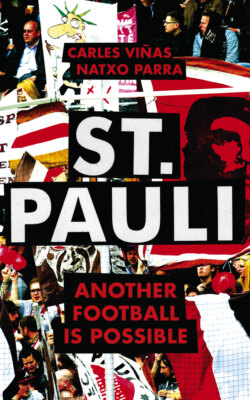St. Pauli

Реклама. ООО «ЛитРес», ИНН: 7719571260.
Оглавление
Carles Vinas. St. Pauli
St. Pauli
Contents
Acknowledgements
Foreword
Abbreviations
Preface
1. The Birth of German Football
2. Football Reaches Hamburg, Sankt Pauli is Founded
3. The Club’s Early Years
4. Sankt Pauli under the Swastika
5. Postwar Successes and the Magnificent Eleven
6. The New Millerntor Stadium
7. Creation of the German League
8. From the Regional Leagues to the Second Division
9. Transition from Neighbourhood to Kult Club
10. Fußball Gegen Nazis
11. A Unique Mix of Football and Social Projects
12. The Rebel’s Choice of St. Pauli-Celtic
13. From Hell to Centenary
14. Social Romantics Try to Reclaim the Club
15. Stadium Ultras’ Antifascism in 2002
16. Global Expansion and the Fan Clubs in England, Scotland and Ireland
17. The Unfinished Business of Women’s Football
18. Music, Democracy and Solidarity in the District and Stadium
19. St. Pauli is the Only Option
Epilogue. Against Modern Football
Bibliography
FILMOGRAPHY
DOCUMENTARIES
ARTICLES IN SPECIALISED JOURNALS
MEDIA CONSULTED
Index
Отрывок из книги
St. Pauli
Carles Viñas and Natxo Parra
.....
4. St. Pauli’s geographical location explains why it became a place for leisure. It was here that the inhabitants of Altona, a conservative town that had preserved the puritanism of the Hanseatic spirit, relaxed. The area’s first wooden theatres were built in the very centre of St. Pauli. These Spielbuden hosted the wildest shows. Also, unsurprisingly, the district had a red-light district where sailors coming offshore at the port would go for a drink and some company. The place gradually began to urbanise in 1864 when Altona was annexed to Prussia. This led to a curve in construction and demographic growth – as was shown by the 72,000 inhabitants counted in 1894. But it was not until the beginning of the nineteenth century that Sankt Pauli became a significant urban hub with its own workers’ community. This happened under the wing of several newly established factories which located there due to lack of space inside the city walls. Alongside this growth, St. Pauli progressively became Hamburg’s red-light district.
5. Curiously, the German word ‘tor means ‘goal’. N. Davidson, Pirates, Punks and Politics. FC St. Pauli: Falling in Love with a Radical Football Club (York: Sport Books, 2014), p. 25.
.....